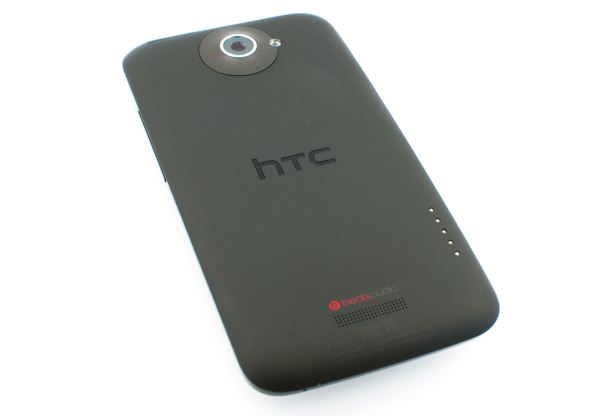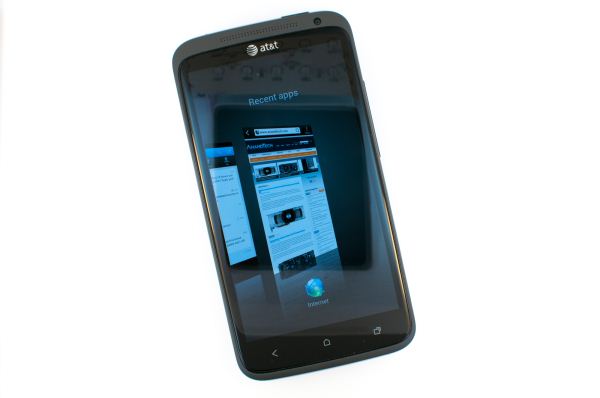The HTC One X for AT&T Review
by Brian Klug on May 1, 2012 6:00 PM EST- Posted in
- Smartphones
- Snapdragon
- HTC
- Qualcomm
- MSM8960
- Krait
- Mobile
- Tegra 3
- HTC One
- NVIDIA
Conclusions and Final Thoughts
The HTC One X is quite simply the smartphone we wished Google had launched Ice Cream Sandwich. It has an amazing display, arguably the best balance of performance and power efficiency in an SoC and a truly outstanding design. In a sea of Android devices that mostly look the same, the HTC One X definitely stands out. It really is the best Android smartphone on the market today.
The industrial design and build quality are easily the best HTC has ever put forward. The One X feels incredibly solid and just looks great. The slight curve to the front surface lets you glide your finger smoothly over the display without hitting an abrupt edge as you approach the end of the device. The back of the One X is distinctly HTC, but obviously more modern. Of anything that has launched thus far, it's probably our favorite looking Android smartphone.
The conclusion for all of HTC's One series reads pretty much the same - HTC has done an extraordinary job both creating its next generation of devices (the One S and One X specifically) and identifying the importance of a concise, unified message. Getting behind either a single device or series and being consistent about it is quite honestly the only way to do battle with the Samsungs and Apples of the world, both of which get this concept and have practiced it for a while now. Unified camera experience, software experience, industrial design, and accessories will make or break this next iteration for the rest of the handset makers. We're still working on finishing our review of the other HTC Ones (One S International, One X International, One S T-Mobile) but my thoughts remain the same for the One X International with Tegra 3 and the other One Ses with Krait - these are without question the best phones HTC has ever made purely because the experience of everything else is kept continuous across the board.
Thankfully the praise doesn't stop with aesthetics. Internally HTC has put together the best hardware available on the market today. The 720p Infinity Screen has the best contrast ratio of any smartphone we've tested, and is among the brightest we've used as well. There's no PenTile to worry about, it's simply one of the best displays if not the best we've reviewed in a phone.
The Qualcomm Snapdragon S4 (MSM8960, "Krait") SoC is easily the fastest or among the fastest on the market today. Android feels very smooth and snappy on the AT&T One X. Applications load quickly, as do web pages. Although the GPU isn't all that new, GPU performance is still quite good. The big draw however is the power efficiency of the hardware platform. In many cases the AT&T One X delivers either the best or among the best battery life of any smartphone we've tested.
For those of you wondering about the Snapdragon S4 vs. Tegra 3 comparison, the answer is pretty simple. It's very difficult to tell the performance difference between these two SoCs in day to day usage. Qualcomm has the scalar performance advantage, while NVIDIA has the heavily threaded performance advantage. On the GPU side, there's likely an NVIDIA advantage there as well. However in practice, you'd be hard pressed to tell the international (Tegra 3) One X and AT&T (S4) One X apart based on performance. Battery life however is a different story entirely. Today, the AT&T One X offers tangibly better battery life than the international version. There are software updates on the way for the One X (Tegra 3) that may narrow the gap, but we'll have to wait and see.
Then there's the camera. Once again, HTC is able to deliver one of the best if not the best smartphone camera with the One X. Low light performance in particularly impressive. The new Sense camera UI is a great match for the hardware as well. The ability to take photos while recording a video without a costly mode switch is both innovative and incredibly useful.
For months we've been recommending waiting for the first 28nm based smartphones before making a purchase. Our biggest fear was that the first 28nm LTE products would show up and be unimpressive, prolonging the wait. Thankfully HTC has put our worries to rest. The One X is an amazing first productization of Qualcomm's Snapdragon S4. It's absolutely everything we wanted. Furthermore, unlike phones released over the past 6 months, you aren't buying into an aging platform. There will be further revisions on Qualcomm's 28nm silicon, and a bunch of exciting stuff coming out early next year, but the One X's hardware won't be immediately obsolete.
If you've been waiting to buy a high-end Android smartphone, the One X is really the only one to get on AT&T.












137 Comments
View All Comments
frostyfiredude - Tuesday, May 1, 2012 - link
If there is one difference that really stood out between the International and ATT versions of the One X, it's the battery life. For all the talking nVidia did about Tegra3 allowing world beating battery life, it really got served by the S4 in that regard.In the fall I really hope HTC makes a One X like phone with WP8 on it, if I'm not feeling cheap I think I'll buy one.
ImSpartacus - Tuesday, May 1, 2012 - link
Yeah, that's really the most important thing for me. I'm glad Anandtech puts it earlier in the reviews.Chloiber - Wednesday, May 2, 2012 - link
It's true. I'm currently owning a One X (international). I'm okay with the battery life (it's better than my previously HTC Desire). But as Brian has mentioned, software updates are on the way. The second update has been released yesterday. The updates are coming out nearly weekly! The improvements are huge in many aspects. The last update (released yesterday in Europe for unbranded devices) finally enabled 2D GPU Acceleration. That's right: 2D GPU Acceleration wasn't working properly before. It couldn't even be forced in the dev settings.I really hope they can improve the device even more, and I'm pretty confident they will. To be perfectly honest, I would have preferred the S4 version of the One X. Nvidia still seems to have some problems with the T3 - again, I'm confident that the device's performance and battery life will improve massively over the next couple of months, but S4 seems to be the safer bet.
pikahatonjon - Tuesday, May 1, 2012 - link
i know its offtopic, however, how come it seems like the Droid Razr performs like 40% better than the galaxy nexus 58.7 fps vs 33.1 when they both have the same SoC? was there some error in the testfrostyfiredude - Tuesday, May 1, 2012 - link
Higher resolution display on the Nexus would be the cause of most if not all of the difference. 960x540 for the RAZR v 1280x720 for the NexusPyroHoltz - Wednesday, May 2, 2012 - link
I really wish Anandtech would normalize the graphics benchmarks to FPS/megapixel of screen resolution.Or, implement something that will take the fluctuations in native resolution, out of the equation a bit.
Goty - Wednesday, May 2, 2012 - link
Just look at the "offscreen" numbers, those are all rendered at the same resolution regardless of handset.ChronoReverse - Wednesday, May 2, 2012 - link
The Offscreen Test is a seriously flawed one. It's clear that the act of rendering to the screen has a different penalty for different GPU's.Since you have to render in actual 3D applications, this means that the Offscreen test is worse than useless since it's _misleading_.
You can't even say it's a VSync issue because in this very article, you have the GLBenchmark test at 720P where the results for both the Global and ATT OneX phones are both significantly below 59-60FPS.
Goty - Wednesday, May 2, 2012 - link
Writing of the framebuffer to the screen is the least part of what each GPU has to do and certainly has less of an impact that differing resolutions between screens; I highly doubt that writing out the framebuffer is even that different between different architectures.metafor - Thursday, May 3, 2012 - link
It's very much in line with the V-Sync results we've seen with the MDP and other devices that allow you to turn V-Sync off.The tests with the Qualcomm MDP show exactly this kind of difference with V-Sync turned on and off, even if the resulting average doesn't come close to 60fps.
Why? Because framerate can vary by a lot within the running of the benchmark. Simple sequences can burst up to the 100's of frames per second. That will throw off the average by a lot.